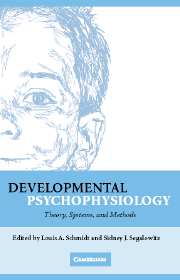Book contents
- Frontmatter
- Contents
- Foreword by Stephen W. Porges
- Preface
- Acknowledgments
- Contributors
- 1 Capturing the Dynamic Endophenotype: A Developmental Psychophysiological Manifesto
- SECTION ONE CENTRAL SYSTEM: THEORY, METHODS, AND MEASURES
- SECTION TWO AUTONOMIC AND PERIPHERAL SYSTEMS: THEORY, METHODS, AND MEASURES
- 7 Infant Heart Rate: A Developmental Psychophysiological Perspective
- 8 Examining Cognitive Development Using Psychophysiological Correlates: Evidence of a Hierarchy of Future-Oriented Processes Across Measures
- 9 Measuring the Electromyographic Startle Response: Developmental Issues and Findings
- 10 The Measurement of Electrodermal Activity in Children
- SECTION THREE NEUROENDOCRINE SYSTEM: THEORY, METHODS, AND MEASURES
- SECTION FOUR DATA ACQUISITION, REDUCTION, ANALYSIS, AND INTERPRETATION: CONSIDERATIONS AND CAVEATS
- Index
- References
8 - Examining Cognitive Development Using Psychophysiological Correlates: Evidence of a Hierarchy of Future-Oriented Processes Across Measures
from SECTION TWO - AUTONOMIC AND PERIPHERAL SYSTEMS: THEORY, METHODS, AND MEASURES
Published online by Cambridge University Press: 27 July 2009
- Frontmatter
- Contents
- Foreword by Stephen W. Porges
- Preface
- Acknowledgments
- Contributors
- 1 Capturing the Dynamic Endophenotype: A Developmental Psychophysiological Manifesto
- SECTION ONE CENTRAL SYSTEM: THEORY, METHODS, AND MEASURES
- SECTION TWO AUTONOMIC AND PERIPHERAL SYSTEMS: THEORY, METHODS, AND MEASURES
- 7 Infant Heart Rate: A Developmental Psychophysiological Perspective
- 8 Examining Cognitive Development Using Psychophysiological Correlates: Evidence of a Hierarchy of Future-Oriented Processes Across Measures
- 9 Measuring the Electromyographic Startle Response: Developmental Issues and Findings
- 10 The Measurement of Electrodermal Activity in Children
- SECTION THREE NEUROENDOCRINE SYSTEM: THEORY, METHODS, AND MEASURES
- SECTION FOUR DATA ACQUISITION, REDUCTION, ANALYSIS, AND INTERPRETATION: CONSIDERATIONS AND CAVEATS
- Index
- References
Summary
INTRODUCTION
In order to effectively function in the world, it is critical that we be able to prepare for future events. The “future” event can be anything from events that will happen in a few seconds to events that will happen in days, weeks, or months. A very general term that has been applied to such abilities or activities is “future-oriented processes” (Haith, Benson, Roberts, & Pennington, 1994). Often we are aware that an event is going to take place in the future due to a warning event. Information inherent in the warning event itself or information from our past experience with that warning event can inform us about both the nature and the timing of the upcoming event. For example, when the traffic light turns yellow, from past experience we know it soon will turn red and approximately how long this will take. In cases when we have knowledge about or experience with the future event we can not only tailor our anticipation or preparation regarding the nature of the upcoming event, but we can also time them so to be optimally ready when the event occurs, and not too early or too late to be effective.
Among the most pervasive and effective paradigms used in the investigations of these future-oriented processes is the simple paired-stimulus or S1-S2 paradigm. In the typical use of this paradigm an initial stimulus or event with minimal inherent significance is followed after a fixed duration by a more significant stimulus or event.
Information
- Type
- Chapter
- Information
- Developmental PsychophysiologyTheory, Systems, and Methods, pp. 213 - 256Publisher: Cambridge University PressPrint publication year: 2007
